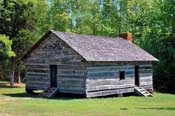Shiloh - Tennessee Historic Site

THE BATTLE OF SHILOH
One of the most significant conflicts in what was called the “western theatre” of the Civil War, the Battle of Shiloh (also known as thee Battle of Pittsburg Landing) in southwestern Tennessee was fought on April 6th- 7th, 1862. In what was the bloodiest battle in U.S. history up until that time, this event showed both sides that the confrontation between North and South would likely be long and catastrophic. The Union Army under General Ulysses S. Grant had sailed down the Tennessee River and camped along the west bank of the waterway. Confederate forces under Generals Albert Sidney Johnston and P.G.T. Beauregard launched a surprise attack, hoping to force their opponents into the untenable swampland of Owl Creek to the west before Union reinforcements could arrive. In the frenzied fighting on the first day, the Confederates seemed to score an overwhelming victory, but became confused, allowing Grant to fall back instead to the northeast. Union Generals Benjamin Prentiss and W.H.L. Wallace maintained their strength in a location that became known as the “Hornet’s Nest”, allowing Grant to regroup and reconfigure his position. In the first day’s fighting, Confederate General Johnston was killed; his second in command- General Beauregard- decided against assaulting the Union position, possibly a decisive mistake in the outcome of the conflagration.
On the evening of the first day, Union reinforcements arrived, attacking the next day and driving the Confederates from the field of battle. Total casualties (killed, wounded and captured or missing in action) numbered over 23,000. Although Union forces sustained more killed and wounded than the rebels, the standard rule that “he who leaves the battlefield first is vanquished” applied. The North won a victory, but paid a heavy price.
Today the Battle of Shiloh is remembered at the Shiloh National Military Park which contains a visitor center along with the Cemetary and Shiloh Indian Mounds.
